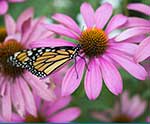Monarch butterflies are the poster children for declining butterfly species, but there are things we can do to help them. Test your knowledge about this butterfly, its relatives and its habitat in our region. No peeking! Answers posted below.

Quiz Questions
1. How many species of butterflies are there in northern Illinois/southern Wisconsin?
A) More than 5
B) More than 10
C) More than 50
D) More than 100
2.By what percentage has the monarch population declined in the past 20 years?
A) 20-30 percent
B) 40-50 percent
C) 60-70 percent
D) 80-90 percent
3. What’s the main reason for the decline of the monarch?
A) Natural predators
B) Massive habitat loss and widespread use of pesticide
C) A butterfly fungal disease
D) Temperature changes
4. All local butterfly populations are declining, true or false?
A) True
B) False
5. Monarch butterflies are distasteful to birds because of toxins in the milkweed on which they feed. What other butterfly species has evolved to closely resemble the monarch so that birds leave it alone, too?
A) Summer Azure
B) Great Spangled Fritillary
C) Viceroy
D) Swamp Metalmark
6. Which of these garden plants are useful for butterflies to feed on in the fall?
A) Mums
B) Calla lilies
C) Goldenrod & Asters
D) Tulips
7. Monarchs depend upon milkweed plants for survival because they’re the only plants on which monarch caterpillars feed. How many milkweed species are native to North America?
A) More than 10
B) More than 30
C) More than 70
D) More than 100
8. What’s the biggest threat to milkweed?
A) Grassland conversion to cropland
B) Climate change
C) Disease
D) Birds
9. All American monarchs migrate to Mexico for the winter months.
A) True
B) False
10. Many of our butterfly species depend upon prairie plants. Of the 22 million acres of prairie that once covered Illinois, what percentage is left?
A) One-hundredth of 1 percent
B) 1 percent
C) 5 percent
D) 10 percent
11. Which of these is not something you should do in your yard to encourage the health of butterfly populations?
A) Plant three seasons of butterfly-friendly plants in dense drifts.
B) Use pesticides to reduce the number of competing
insects.
C) Allow fall and spring leaves to lie so butterflies can overwinter as caterpillars or in chrysalises and reawaken in the spring to complete their life cycles.
D) Allow weed nectar plants to become part of your landscape.
12. Which of the following statements are true?
A) Butterflies can’t hear, but they feel vibrations
B) Butterflies taste with their feet
C) Butterflies smell with their antennae.
D) All of the above
E) None of the above
Quiz Answers
1. D, more than 100 butterfly species exist in our region.
2. D, the monarch population has declined by 80-90 percent.
3. B, massive habitat loss and pesticide use threatens monarch survival.
4. B, some species have adapted to man’s activity.
5. C, the viceroy closely resembles the monarch butterfly. It is pictured at left on p. xx.
6. C, goldenrods and asters provide good fall eating for butterflies.
7. C, more than 70 varieties of milkweed exist in North America.
8. A, More than a million acres per year of grassland is converted to cropland.
9. B, false. Most eastern monarchs migrate to Mexico but some live year-round in Florida. Western monarchs spend the winter along the California coastline.
10. A, one-hundredth of 1 percent of the 22 million acres of prairie that once covered Illinois remains.
11. B, all pesticide use is harmful to butterflies.
12. D, all of the above.























































